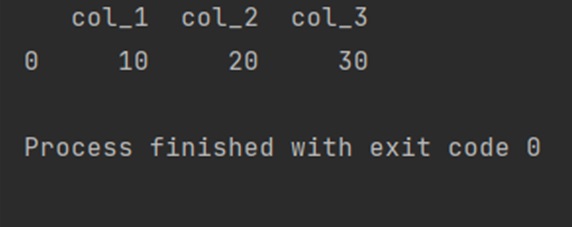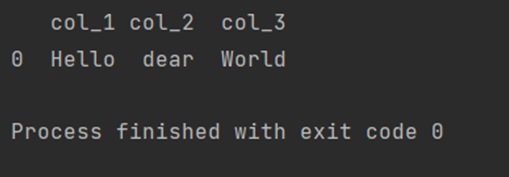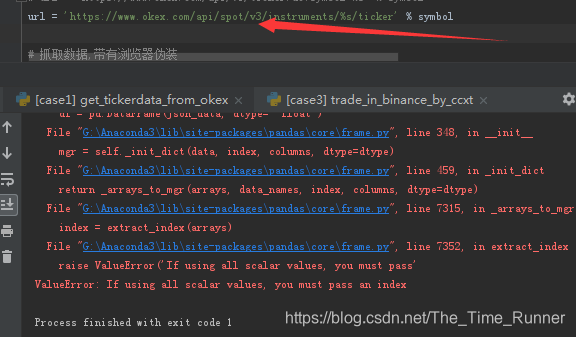If Using All Scalar Values You Must Pass An Index
Understanding the concept of scalar values:
Scalar values, in programming, refer to individual data values that cannot be divided further. These values are atomic and cannot be broken down into smaller components. Examples of scalar values include integers, floating-point numbers, characters, and Boolean values. These values are essential in programming languages as they provide the basic building blocks for more complex data structures.
The necessity of passing an index when using all scalar values:
In many programming languages, when manipulating data that consists entirely of scalar values, it is necessary to pass an index. An index is a numerical value that represents the position of a specific element within a data structure. When working with scalar values, you need to specify the index of the value you want to access or modify.
Passing an index is crucial because it allows the program to locate and manipulate specific scalar values within the data structure. Without an index, the program would not know which value to work with, resulting in errors or unexpected behavior.
Exceptions to passing an index:
While passing an index is generally required when dealing with scalar values, there are some situations where it may not be necessary. For instance, when performing operations that involve all the scalar values in a data structure, such as calculating the sum or average, passing an index for each value individually might not be needed.
Additionally, some programming languages provide built-in functions or methods that allow you to perform operations on the entire dataset without the need for explicit indexing. These functions typically operate on the entire data structure and automatically handle the necessary indexing behind the scenes.
Potential errors when not passing an index with all scalar values:
When you fail to pass an index when working with scalar values, you may encounter various errors depending on the programming language being used. One common error is the “data must be 1-dimensional” error, which occurs when you try to manipulate a data structure without specifying an index or attempting to access a multidimensional data structure as if it were one-dimensional.
Error messages can be helpful in identifying the source of the issue. They provide information on what went wrong and often suggest potential solutions to the problem. When working with scalar values, error messages such as “IndexError: list index out of range” or “KeyError: ‘index'” can indicate that an index was not provided.
Best practices for utilizing scalar values with indexes:
To ensure proper usage of scalar values with indexes, here are some best practices to follow:
1. Understand the data structure: Familiarize yourself with the data structure you are working with and how indexes relate to the scalar values within it. This will help avoid confusion and unnecessary errors.
2. Double-check your index values: Always verify that the index values you provide are valid and within the range of the data structure. Incorrect index values can lead to unexpected behavior or errors.
3. Use appropriate indexing methods: Different programming languages offer various indexing methods for accessing and modifying scalar values. Be sure to utilize the correct syntax and functions provided by the programming language you are using.
4. Take advantage of built-in functions: Programming languages often provide functions or methods that can perform operations on scalar values without explicitly requiring indexes. Utilize these functions when appropriate to simplify your code and improve efficiency.
Benefits of using scalar values with indexes:
Passing an index when working with scalar values offers several benefits:
1. Enhanced functionality: By specifying an index, you gain precise control over which scalar value you want to manipulate. This allows for targeted operations on specific elements within the data structure.
2. Improved performance: When you pass an index, the program can quickly locate the desired scalar value, resulting in better performance compared to searching through the entire data structure.
3. Simplified data manipulation: Indexing makes it easier to perform operations on specific scalar values within a data structure without affecting the rest of the elements. This enables efficient data transformations, filtering, and sorting.
In conclusion, when utilizing all scalar values, passing an index is crucial for proper data manipulation. While there are exceptions and specific situations where explicit indexing may not be required, understanding the concept of indexes and knowing how to use them correctly can greatly enhance your programming capabilities. By following best practices and leveraging the benefits of scalar values with indexes, you can efficiently work with data structures and achieve desired outcomes.
FAQs:
Q: What is an index in programming?
A: In programming, an index refers to a numerical value that represents the position of a specific element within a data structure. It allows for precise access and manipulation of individual elements within the structure.
Q: Are there any exceptions to passing an index with scalar values?
A: Yes, there are situations where passing an index may not be necessary, such as when performing operations that involve all the scalar values in a data structure.
Q: What are some common errors when not passing an index with scalar values?
A: Some common errors include “data must be 1-dimensional” and “IndexError: list index out of range.” These errors indicate that an index was not provided or that the index value is incorrect.
Q: How can I avoid errors when using scalar values with indexes?
A: To avoid errors, it is essential to understand the data structure, double-check index values, use appropriate indexing methods, and take advantage of built-in functions or methods provided by the programming language.
Pandas : Valueerror: If Using All Scalar Values, You Must Pass An Index
Keywords searched by users: if using all scalar values you must pass an index If using all scalar values you must pass an index sns scatterplot, If using all scalar values you must pass an index read_json, data must be 1-dimensional, Create DataFrame with index, Pd concat two dataframes, Convert dict to dataframe python, From_dict got an unexpected keyword argument index, Add row to top of DataFrame pandas
Categories: Top 67 If Using All Scalar Values You Must Pass An Index
See more here: nhanvietluanvan.com
If Using All Scalar Values You Must Pass An Index Sns Scatterplot
Data visualization plays a crucial role in understanding and interpreting complex datasets across various industries. Python, being a versatile programming language, offers numerous libraries and tools to create visually appealing and interactive plots. One such library is seaborn, which provides an extensive range of visualization functions. One of the commonly used functions in seaborn is scatterplot, which helps in plotting data points on a graph. However, when using seaborn’s scatterplot function, it is important to understand the concept of passing an index and using scalar values effectively.
Understanding seaborn.scatterplot
Seaborn.scatterplot is a powerful function that allows users to create scatterplots to visualize relationships between two variables. It offers various customization options, such as adding color, labels, and markers, to enhance the plot’s visual representation. Scatterplots are particularly useful when analyzing continuous numerical data as they help establish patterns and trends.
Using Seaborn.scatterplot to Plot Scalar Values
When using seaborn.scatterplot, passing an index is required when plotting scalar values. An index is essentially a sequence of numbers that uniquely identifies each data point in the plot. It serves as a referencing system that helps locate and distinguish individual data points in the scatterplot. The index allows users to differentiate between various data points, particularly when using all scalar values.
Passing an Index with Seaborn.scatterplot
To pass an index with seaborn.scatterplot, follow these steps:
1. Import the necessary libraries: Begin by importing both the seaborn and matplotlib libraries. Seaborn requires matplotlib for rendering the visualizations.
“`
import seaborn as sns
import matplotlib.pyplot as plt
“`
2. Create a dataset: Generate a dataset or load one from a file to analyze. Ensure that the dataset contains scalar values for plotting.
3. Create the scatterplot: Now, create the scatterplot using seaborn.scatterplot. Specify the x and y variables, along with the data parameter to reference the dataset. Additionally, pass an index value to the hue parameter to distinguish between different points.
“`
sns.scatterplot(x=’variable_x’, y=’variable_y’, data=dataset, hue=’index_column’)
plt.show()
“`
Using these steps, you can effectively plot scatterplots with scalar values while passing an index.
FAQs
Q1. Why is passing an index important when using all scalar values in seaborn.scatterplot?
A1. Passing an index is essential when using scalar values as it helps differentiate between individual data points in the scatterplot. It provides a referencing system that allows clear identification and analysis of specific data points.
Q2. Can you plot scatterplots without passing an index?
A2. While it is technically possible to plot scatterplots without passing an index, it is not recommended when using all scalar values. Without an index, it becomes challenging to distinguish between individual data points accurately.
Q3. How can I customize my scatterplot further?
A3. Seaborn.scatterplot offers various customization options by providing additional parameters. You can modify the colors, labels, markers, and other attributes to enhance your scatterplot’s visual appeal and better convey information.
Q4. What other types of plots can seaborn create?
A4. Seaborn offers a wide range of plot types, including bar plots, line plots, box plots, violin plots, and more. Each plot type caters to different data analysis requirements and allows you to visualize data from multiple perspectives.
Q5. Can seaborn be used only for scalar values?
A5. No, seaborn can be used to create visualizations for various data types, including categorical, ordinal, and even textual data. Each data type has specific plotting functions designed to handle their unique characteristics.
Conclusion
Understanding the concept of passing an index when using seaborn.scatterplot with all scalar values is crucial for effectively visualizing data. The ability to discern individual data points accurately enhances the plot’s interpretability and allows for more insightful analysis. By following the steps discussed in this article, you can confidently create scatterplots with scalar values while passing an index. Seaborn, with its vast array of customization options and other plot types, remains a valuable tool for any data visualization task.
If Using All Scalar Values You Must Pass An Index Read_Json
JSON (JavaScript Object Notation) is a lightweight data interchange format that has gained immense popularity due to its simplicity and easy integration with different programming languages. It provides a human-readable and easy-to-parse structure, making it ideal for data representation and exchange between systems. One of the key functionalities in handling JSON data is reading and parsing it using appropriate tools and libraries.
In the Python programming language, the pandas library offers a variety of functions for data manipulation and analysis. One such function is read_json, which enables users to read and parse JSON data into a pandas DataFrame. Typically, read_json is straightforward to use, but there is a specific scenario that requires passing an index if all values in the JSON file are scalar.
To understand this requirement, let’s first delve into the basics of reading JSON data using pandas. The read_json function in pandas allows users to read JSON objects into DataFrame structures. It detects various JSON data formats, including object notation, arrays, records, or semi-structured tables. By default, it assumes the JSON file contains a JSON object per line, making it easy to work with large datasets.
When using read_json, if the JSON data is a JSON object notation or semi-structured table, pandas automatically assigns a unique index to each row of the DataFrame for identification purposes. However, when all the values in the JSON file are scalar, meaning they are indivisible and represent atomic data types (e.g., strings, numbers), pandas cannot directly infer the index. In such cases, an explicit index needs to be specified.
To pass an index while using read_json, users can provide additional arguments. One such argument is “orient.” The orient parameter controls the interpretation or orientation of the JSON data. By default, it is set to “columns,” which implies that the JSON file represents a table-like structure, where each column contains a unique key.
To pass an index, the orient parameter needs to be set to “index.” By doing so, the values in the JSON file are treated as rows, and the index is explicitly specified. This index can be numerical or string-based, depending on the data being read. Below is an example demonstrating the usage of read_json when an index needs to be explicitly passed:
“`python
import pandas as pd
# Scalar JSON data
json_data = ”’
{
“Name”: “John”,
“Age”: 30,
“Country”: “USA”
}
”’
# Reading JSON and specifying the index
df = pd.read_json(json_data, orient=’index’)
print(df)
“`
Output:
“`
0
Name John
Age 30
Country USA
“`
In the example above, the JSON data consists of scalar values representing attributes of an individual. By setting `orient=’index’`, the keys (“Name,” “Age,” and “Country”) are treated as the index, and the corresponding values are displayed in the DataFrame.
Frequently Asked Questions (FAQs):
Q: Is it necessary to pass an index when all values in the JSON file are scalar?
A: Yes, when all values in the JSON file are scalar, an explicit index needs to be specified using the `orient` parameter in the `read_json` function.
Q: Can I use a numerical index when reading scalar JSON data?
A: Yes, you can use either a numerical or string-based index depending on your preference and the context of the data being read.
Q: What happens if I do not pass an index while reading scalar JSON data?
A: Pandas cannot infer the index automatically, resulting in a DataFrame with default numeric indices. This may lead to ambiguity in identifying the data entries.
Q: Are there any other arguments that can be useful in reading scalar JSON data?
A: Apart from orient, the read_json function also provides other optional parameters, such as `dtype`, `convert_dates`, `convert_axes`, etc., depending on the specific requirements of the data being read.
Q: Is it possible to convert the scalar JSON data into a column-wise DataFrame instead of a row-wise DataFrame?
A: Yes, in such cases, you can set the `orient` parameter to `’columns’` instead of `’index’`. This will treat the keys as column names and values as values in the DataFrame.
In conclusion, when working with scalar JSON data using pandas’ read_json function, it becomes necessary to explicitly pass an index to ensure proper identification and representation of the data. By utilizing the `orient` parameter and setting it to `’index’`, users can accurately read scalar JSON data into a pandas DataFrame with the desired index. Remember to be mindful of the data format and index requirements while handling JSON files in your data processing tasks.
Data Must Be 1-Dimensional
In the fast-paced world of technology and data-driven decision making, effective data organization is paramount. It is crucial to understand that data must be 1-dimensional, meaning that it should be structured and organized in a single dimension, to maximize its usability and analytical potential. This article will provide an in-depth exploration of why data needs to be 1-dimensional, offering insights into the benefits it brings and the potential pitfalls of disregarding this principle.
I. The Essence of 1-Dimensional Data
At its core, 1-dimensional data refers to the concept of organizing data in a sequential manner, devoid of ambiguity or complexity. It essentially means that each data point or observation can be uniquely identified and accessed in a systematic manner, allowing for efficient querying and analysis. This organization is commonly achieved through the use of arrays, lists, vectors, or other linear data structures.
II. The Importance of Data Organization
1. Enhanced Analysis Capabilities:
By structuring data in a 1-dimensional format, it becomes easier to extract meaningful insights and draw accurate conclusions. This is particularly true for larger datasets, where a 1-dimensional structure facilitates efficient sorting, searching, and aggregating operations.
2. Efficient Storage and Retrieval:
Storing data in a 1-dimensional format can significantly optimize storage and retrieval operations. This structure eliminates the need for complex hierarchical relationships, reducing the time and resources required for data access. As a result, databases and data warehouses can operate with increased speed and efficiency.
3. Improved Data Integrity:
Organizing data in a 1-dimensional format helps maintain data integrity by reducing redundancy, minimizing data duplication, and enhancing consistency. This simplifies information management and mitigates the risk of errors that may arise from working with complex, multi-dimensional data structures.
III. Challenges & Pitfalls of Multi-Dimensional Data
While multi-dimensional data structures, such as matrices or cubes, have their uses in specific contexts, they come with their own set of challenges and limitations when applied universally. Here are a few reasons why relying solely on multi-dimensional data can be problematic:
1. Complexity and Cognitive Overload:
Working with multi-dimensional data can quickly become overwhelming, making it difficult to comprehend and manipulate. The intricate relationships between dimensions create a cognitive load that slows down analysis and decision-making processes.
2. Inflexibility and Scalability Issues:
Multi-dimensional data structures often lack flexibility, making them less adaptable to evolving business needs. When new dimensions need to be added or existing ones modified, substantial effort is required to reshape the entire dataset. This inflexibility may hinder scalability and limit the response to emerging analytical requirements.
FAQs:
1. Why does data need to be structured in a 1-dimensional format?
Data should be organized in a 1-dimensional format to enhance analysis capabilities, enable efficient storage and retrieval, and improve data integrity and consistency. This structure simplifies data management and facilitates faster data processing.
2. Can’t we have both 1-dimensional and multi-dimensional data structures in a database?
Indeed, databases commonly utilize a combination of 1-dimensional and multi-dimensional data structures to cater to different requirements. However, it is crucial to emphasize that the core organizational principles of the data should prioritize a 1-dimensional format.
3. Are there any exceptions or specific cases where multi-dimensional data structures are more suitable?
Yes, in certain specialized domains, such as geographical information systems or scientific simulations, multi-dimensional data structures can be more appropriate. These structures are designed to handle specific complexities and relationships that cannot be easily represented in a 1-dimensional format.
In conclusion, data must be 1-dimensional to harness its full potential in analysis, decision-making, and storage. This organization allows for enhanced analysis capabilities, efficient storage, and improved data integrity. While multi-dimensional data structures have their place, relying exclusively on them can introduce complexity, inflexibility, and scalability issues. By prioritizing the 1-dimensional nature of data, organizations can unlock actionable insights and pave the way for more effective data-driven strategies.
Images related to the topic if using all scalar values you must pass an index

Found 40 images related to if using all scalar values you must pass an index theme






![Python Error] ValueError: If using all scalar values, you must pass an index Python Error] Valueerror: If Using All Scalar Values, You Must Pass An Index](https://blog.kakaocdn.net/dn/bugVJR/btq4UdABAon/4L22WdDvjsPuerXTJtDjlK/img.png)







![Python] ValueError: If using all scalar values, you must pass an index Python] Valueerror: If Using All Scalar Values, You Must Pass An Index](https://img1.daumcdn.net/thumb/R750x0/?scode=mtistory2&fname=https%3A%2F%2Fblog.kakaocdn.net%2Fdn%2FAnlAe%2FbtrbHcQBmOI%2FUTkyFBN5Jno5duEeg8Yv2k%2Fimg.jpg)







![python] ValueError: If using all scalar values, you must pass an index Python] Valueerror: If Using All Scalar Values, You Must Pass An Index](https://img1.daumcdn.net/thumb/C176x176/?fname=https://blog.kakaocdn.net/dn/U3Tth/btqDx6ofVKL/zB21Szbr908dSFwxdoCbP0/img.png)


Article link: if using all scalar values you must pass an index.
Learn more about the topic if using all scalar values you must pass an index.
- ValueError: If using all scalar values, you must pass an index
- How to Fix: if using all scalar values, you must pass an index
- ValueError if using all scalar values, you must pass an index
- How to Fix: if using all scalar values, you must pass an index
- Valueerror: if using all scalar values … – Net-Informations.Com
- If using all scalar values, you must pass an index” in Pandas
- {valueerror}if using all scalar values, you must pass an index …
- If using all scalar values, you must pass an index, How to Fix it?
- If using all scalar values, you must pass an index”-pandas
See more: nhanvietluanvan.com/luat-hoc